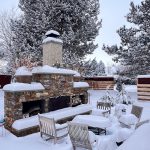
 It’s the dead of winter, and a great time of year for gardeners! What’s great about winter you ask? I’ll get to that in a minute. First, a weather update for the Idaho Treasure Valley…
It’s the dead of winter, and a great time of year for gardeners! What’s great about winter you ask? I’ll get to that in a minute. First, a weather update for the Idaho Treasure Valley…
Due to a particularly potent El Niño this year, the Farmers Almanac has grouped Idaho with the NW states, Washington and Oregon. For winter 2024, an unusually snowy and wet winter with typical temps in store. The last 10 days has delivered some beautiful snowstorms with some single digit temps. Today in the mid-40’s! The forecast could change in the moment the weather arrives.
What’s great about winter in the garden? In January and February, when temperatures are low, your landscape plants are completely dormant. When there is a break in the cold temperatures, it’s a great time of year to prune most evergreen or deciduous trees and shrubs that don’t bloom in the spring.
Deciduous plants and trees drop their leaves in the fall, making them easier to evaluate this time of year. Sap and life giving energies have returned to the roots, meaning pruning now will not compromise the plants vitality.The plant’s true shape and character is visible, and that’s ideal for making good pruning choices.
Just how do you know what to prune and where? A first step is to look for limbs that are damaged, touching, or crossing and prune those first. Next, remove any secondary limbs (not the main apex) that are growing straight up or straight down. That could be all that is needed.
Pruning does an amazing amount of good for the health of your plant. It opens up the tree or shrub and allows more air and sunlight to reach the inner areas. You’ll see a transformation next spring and summer! FYI—many of these concepts are borrowed from bonsai pruning techniques, but generally apply across the landscape.
Caveat on fall and winter pruning—DO NOT CUT SPRING BLOOMING plants or trees in fall or winter. You will remove their developing blossoms! Wait until just after they bloom.

Japanese maple in winter. Never prune a Japanese maple if clear saps runs from the cut. Wait until the tree is completely dormant.
Fall pruning should generally be avoided because it can encourage a growth spurt. Come winter, the young, tender foliage is susceptible to potential winter damage. That plant may not look so great in the spring.
If conditions for pruning are not favorable, don’t completely forget about your landscape through the winter. Plants may need protection from potentially drying winter winds. Products such as ‘Wilt Proof’ can help prevent such damage. Don’t forget to water landscape plants during mild, dry spells, especially container plantings.
Great Better Home & Gardens article on pruning. As you read this note there are lots of caveats on pruning—how, when, and why. I definitely disagree with part of #4—Crape myrtles should never be cut to the ground; #8—when any tree saps heavily when cut delay pruning to a later time.
Better Homes & Gardens, Here’s When to Prune Trees, Shrubs, and Flowers for Healthier Plants
Happy winter gardening!
Tags: gardening, Landscape design, pruning, Snow
Leave a Reply Cancel reply

More Story
New Year, New Plans!
The holiday whirlwind is behind us, and with a new year kicking in, timing is perfect to set some design priorities. Often...Subscribe to the Blog
Site Menu
Recent Posts
- What's a gardener to do... in winter?
Jan 22, 2024 - New Year, New Plans!
Jan 1, 2024 - The Thoughtful Host
Dec 7, 2023
- What's a gardener to do... in winter?

You may link to a post or take quotes if credit, including a link back, is given.
You may not take entire posts or photographs without asking.
Permission may be requested using the contact form .















Share On